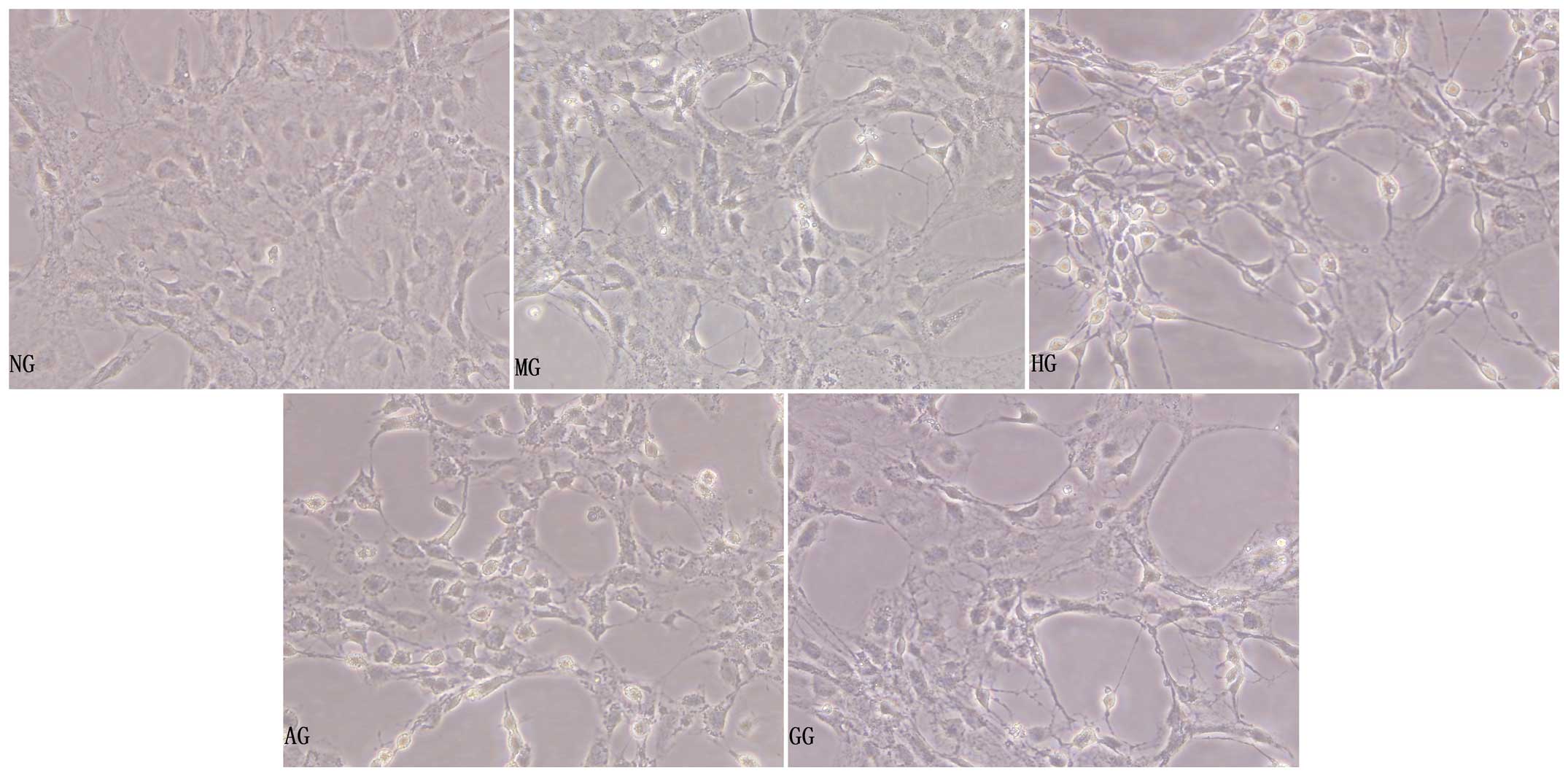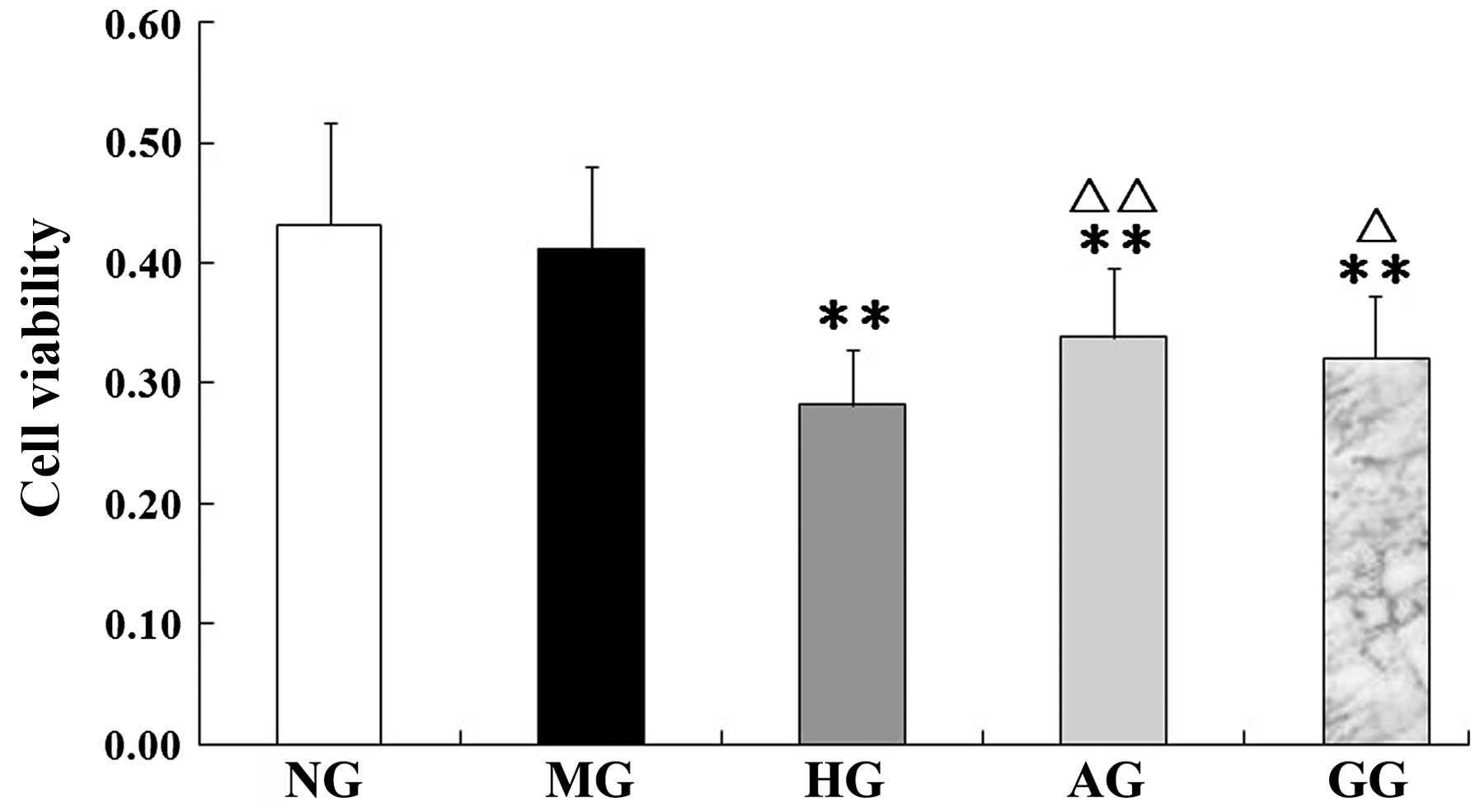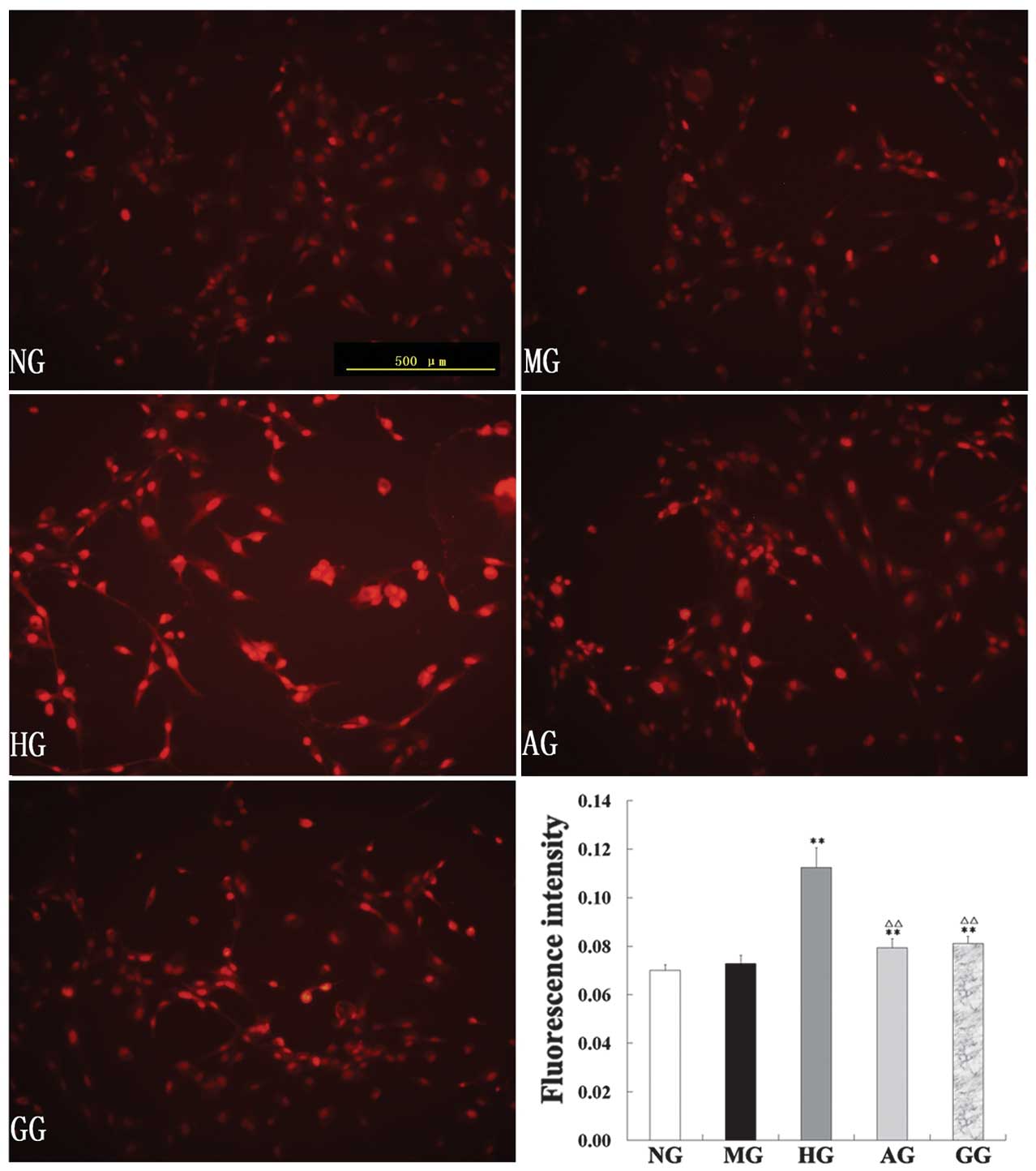|
1
|
Norhammar A, Tenerz A, Nilsson G, Hamsten
A, Efendíc S, Rydén L and Malmberg K: Glucose metabolism in
patients with acute myocardial infarction and no previous diagnosis
of diabetes mellitus: A prospective study. Lancet. 359:2140–2144.
2002. View Article : Google Scholar : PubMed/NCBI
|
|
2
|
Rolo AP and Palmeira CM: Diabetes and
mitochondrial function: Role of hyperglycemia and oxidative stress.
Toxicol Appl Pharmcol. 212:167–178. 2006. View Article : Google Scholar
|
|
3
|
Olmez I and Ozyurt H: Reactive oxygen
species and ischemic cerebrovascular disease. Neurochem Int.
60:208–212. 2012. View Article : Google Scholar : PubMed/NCBI
|
|
4
|
Laderoute KR: The interaction between
HIF-1 and AP-1 transcription factors in response to low oxygen.
Semin Cell Dev Biol. 16:502–513. 2005. View Article : Google Scholar : PubMed/NCBI
|
|
5
|
Nitatori T, Sato N, Waguri S, Waguri S,
Karasawa Y, Araki H, Shibanai K, Kominami E and Uchiyama Y: Delayed
neuronal death in the CA1 pyramidal cell layer of the gerbil
hippocampus following transcient ischemia is apoptosis. J Neurosci.
15:1001–1011. 1995.PubMed/NCBI
|
|
6
|
Patumraj S, Tewit S, Amatyakul S,
Jariyapongskul A, Maneesri S, Kasantikul V and Shepro D:
Comparative effects of garlic and aspirin on diabetic
cardiovascular complications. Drug Deliv. 7:91–96. 2000. View Article : Google Scholar : PubMed/NCBI
|
|
7
|
Eidi A, Eidi M and Esmaeili E:
Antidiabetic effect of garlic (Allium sativum L.) in normal
and streptozotocin-induced diabetic rats. Phytomedicine.
13:624–629. 2006. View Article : Google Scholar : PubMed/NCBI
|
|
8
|
Ashraf R, Khan RA and Ashraf I: Garlic
(Allium sativum) supplementation with standard antidiabetic
agent provides better diabetic control in type 2 diabetes patients.
Pak J Pharm Sci. 24:565–570. 2011.PubMed/NCBI
|
|
9
|
Nasim SA, Dhir B, Kapoor R, Fatima S,
Mahmooduzzafar and Mujib A: Alliin obtained from leaf extract of
garlic grown under in situ conditions possess higher therapeutic
potency as analyzed in alloxan-induced diabetic rats. Pharm Biol.
49:416–421. 2011. View Article : Google Scholar : PubMed/NCBI
|
|
10
|
Borek C: Garlic reduces dementia and
heart-disease risk. J Nutr. 136:(3 Suppl). S810–S812. 2006.
|
|
11
|
Ou CC, Tsao SM, Lin MC and Yin MC:
Protective action on human LDL against oxidation and glycation by
four organosulfur compounds derived from garlic. Lipids.
38:219–224. 2003. View Article : Google Scholar : PubMed/NCBI
|
|
12
|
Liu DS, Gao W, Liang ES, Wang SL, Lin WW,
Zhang WD, Jia Q, Guo RC and Zhang JD: Effects of allicin on
hyperhomocysteinemia-induced experimental vascular endothelial
dysfunction. Eur J Pharmacol. 714:163–169. 2013. View Article : Google Scholar : PubMed/NCBI
|
|
13
|
Rajani Kanth V, Uma Maheswara Reddy P and
Raju TN: Attenuation of streptozotocin-induced oxidative stress in
hepatic and intestinal tissues of Wistar rat by methanolic-garlic
extract. Acta Diabetol. 45:243–251. 2008. View Article : Google Scholar : PubMed/NCBI
|
|
14
|
Guzik TJ, Mussa S, Gastaldi D, Sadowski J,
Ratnatunga C, Pillai R and Channon KM: Mechanisms of increased
vascular superoxide production in human diabetes mellitus: Role of
NAD(P)H oxidase and endothelial nitric oxide synthase. Circulation.
105:1656–1662. 2002. View Article : Google Scholar : PubMed/NCBI
|
|
15
|
Liu DS, Zhou YH, Liang ES, Li W, Lin WW,
Chen FF and Gao W: Neuroprotective effects of the Chinese
Yi-Qi-Bu-Shen recipe extract on injury of rat hippocampal neurons
induced by hypoxia/reoxygenation. J Ethnopharmacol. 145:168–174.
2013. View Article : Google Scholar : PubMed/NCBI
|
|
16
|
Bryden KS, Dunger DB, Mayou RA, Peveler RC
and Neil HA: Poor prognosis of young adults with type 1 diabetes: A
longitudinal study. Diabetes Care. 26:1052–1057. 2003. View Article : Google Scholar : PubMed/NCBI
|
|
17
|
Mäkinen VP, Forsblom C, Thorn LM, Wadén J,
Kaski K, Ala-Korpela M and Groop PH: Network of vascular diseases,
death and biochemical characteristics in a set of 4,197 patients
with type 1 diabetes (the FinnDiane Study). Cardiovasc Diabetol.
8:542009. View Article : Google Scholar : PubMed/NCBI
|
|
18
|
Brownlee M: The pathobiology of diabetic
complications: A unifying mechanism. Diabetes. 54:1615–1625. 2005.
View Article : Google Scholar : PubMed/NCBI
|
|
19
|
Duchen MR: Roles of mitochondria in health
and disease. Diabetes. 53:(Suppl 1). S96–S102. 2004. View Article : Google Scholar : PubMed/NCBI
|
|
20
|
Nishikawa T, Edelstein D, Du XL, Yamagishi
S, Matsumura T, Kaneda Y, Yorek MA, Beebe D, Oates PJ, Hammes HP,
et al: Normalizing mitochondrial superoxide production blocks three
pathways of hyperglycaemic damage. Nature. 404:787–790. 2000.
View Article : Google Scholar : PubMed/NCBI
|
|
21
|
Kiritoshi S, Nishikawa T, Sonoda K,
Kukidome D, Senokuchi T, Matsuo T, Matsumura T, Tokunaga H,
Brownlee M and Araki E: Reactive oxygen species from mitochondria
induce cyclooxygenase-2 gene expression in human mesangial cells:
Potential role in diabetic nephropathy. Diabetes. 52:2570–2577.
2003. View Article : Google Scholar : PubMed/NCBI
|
|
22
|
Retinopathy and nephropathy in patients
with type 1 diabetes four years after a trial of intensive therapy.
The diabetes control and complications trial/epidemiology of
diabetes interventions and complications research group. N Engl J
Med. 342:381–389. 2000. View Article : Google Scholar : PubMed/NCBI
|
|
23
|
Tuzgen S, Hamnimoglu H, Tanriverdi T,
Kacira T, Sanus G, Atukereny P, Dashti R, Gumustas K, Canbaz B and
Kaynar MY: Relationship between DNA damage and total antioxidant
capacity in patients with glioblastoma multiforme. Clin Oncol (R
Coll Radiol). 19:177–181. 2007. View Article : Google Scholar : PubMed/NCBI
|
|
24
|
Inoguchi T, Battan R, Handler E, Sportsman
JR, Heath W and King GL: Preferential elevation of protein kinase C
isoform beta II and diacylglycerol levels in the aorta and heart of
diabetic rats: Differential reversibility to glycemic control by
islet cell transplantation. Proc Natl Acad Sci USA. 89:11059–11063.
1992. View Article : Google Scholar : PubMed/NCBI
|
|
25
|
Craven PA, Studer RK, Negrete H and
DeRubertis FR: Protein kinase C in diabetic nephropathy. J Diabetes
Complications. 9:241–245. 1995. View Article : Google Scholar : PubMed/NCBI
|
|
26
|
Koya D, Jirousek MR, Lin YW, Ishii H,
Kuboki K and King GL: Characterization of protein kinase C beta
isoform activation on the gene expression of transforming growth
factor-beta, extracellular matrix components and prostanoids in the
glomeruli of diabetic rats. J Clin Invest. 100:115–126. 1997.
View Article : Google Scholar : PubMed/NCBI
|
|
27
|
Brownlee M: Biochemistry and molecular
cell biology of diabetic complications. Nature. 414:813–820. 2001.
View Article : Google Scholar : PubMed/NCBI
|
|
28
|
Hamilton CA, Miller WH, Al-benna S,
Brosnan J, Drummond RD, McBride MW and Dominiczak AF: Strategies to
reduce oxidative stress in cardiovascular diaease. Clin Sci (Lond).
106:219–234. 2004. View Article : Google Scholar : PubMed/NCBI
|
|
29
|
Dekker LV, Leitges M, Altschuler G, Mistry
N, McDermott A, Roes J and Segal AW: Protein kinase C-beta
contributes to NADPH oxidase activation in neutrophils. Biochem J.
347:285–289. 2000. View Article : Google Scholar : PubMed/NCBI
|
|
30
|
Serrander L, Cartier L, Bedard K, Banfi B,
Lardy B, Plastre O, Sienkiewicz A, Fórró L, Schlegel W and Krause
KH: NOX4 activity is determined by mRNA levels and reveals a unique
pattern of ROS generation. Biochem J. 406:105–114. 2007. View Article : Google Scholar : PubMed/NCBI
|
|
31
|
Gorin Y, Block K, Hernandez J, Bhandari B,
Wagner B, Barnes JL and Abboud HE: Nox4 NAD(P)H oxidase mediates
hypertrophy and fibronectin expression in the diabetic kidney. J
Biol Chem. 280:39616–39626. 2005. View Article : Google Scholar : PubMed/NCBI
|
|
32
|
Goyal P, Weissmann N, Rose F, Grimminger
F, Schäfers HJ, Seeger W and Hänze J: Identification of novel Nox4
splice variants with impact on ROS levels in A549 cells. Biochem
Biophys Res Commun. 329:32–39. 2005. View Article : Google Scholar : PubMed/NCBI
|
|
33
|
Griendling KK: Novel NAD(P)H oxidases in
the cardiovascular system. Heart. 90:491–493. 2004. View Article : Google Scholar : PubMed/NCBI
|
|
34
|
San Martín A, Du P, Dikalova A, Lassègue
B, Aleman M, Góngora MC, Brown K, Joseph G, Harrison DG, Taylor WR,
et al: Reactive oxygen species-selective regulation of aortic
inflammatory gene expression in Type 2 diabetes. Am J Physiol Heart
Circ Physiol. 292:H2073–H2082. 2007. View Article : Google Scholar : PubMed/NCBI
|
|
35
|
Thandavarayan RA, Watanabe K, Ma M,
Gurusamy N, Veeraveedu PT, Konishi T, Zhang S, Muslin AJ, Kodama M
and Aizawa Y: Dominant-negative p38 mitogen-activated protein
kinase prevents cardiac apoptosis and remodeling after
streptozotocin-induced diabetes mellitus. Am J Physiol Heart Circ
Physiol. 297:H911–H919. 2009. View Article : Google Scholar : PubMed/NCBI
|
|
36
|
Yerneni KK, Bai W, Khan BV, Medford RM and
Natarajan R: Hyperglycemia-induced activation of nuclear
transcription factor kappaB in vascular smooth muscle cells.
Diabetes. 48:855–864. 1999. View Article : Google Scholar : PubMed/NCBI
|
|
37
|
Cameron NE, Eaton SE, Cotter MA and
Tesfaye S: Vascular factors and metabolic interactions in the
pathogenesis of diabetic neuropathy. Diabetologia. 44:1973–1988.
2001. View Article : Google Scholar : PubMed/NCBI
|
|
38
|
Klimova T and Chandel NS: Mitochondrial
complex III regulates hypoxic activation of HIF. Cell Death Differ.
15:660–666. 2008. View Article : Google Scholar : PubMed/NCBI
|
|
39
|
Fandrey J, Gorr TA and Gassmann M:
Regulating cellular oxygen sensing by hydroxylation. Cardiovasc
Res. 71:642–651. 2006. View Article : Google Scholar : PubMed/NCBI
|
|
40
|
Madkor HR, Mansour SW and Ramadan G:
Modulatory effects of garlic, ginger, turmeric and their mixture on
hyperglycaemia, dyslipidaemia and oxidative stress in
streptozotocin-nicotinamide diabetic rats. Br J Nutr.
105:1210–1217. 2011. View Article : Google Scholar : PubMed/NCBI
|
















